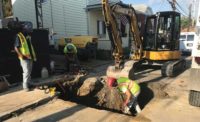...350-million gallon-per-day (mgd) ultraviolet water-treatment facility. On the other are four 3,000-ft-long underground tunnels that convey water from the Coast Range Tunnel to the Irvington Tunnel, which, in turn, carries water from the Sunol Valley to the Mission San Jose District of Fremont.
The shutdown team synchronized work on both projects so that the tunnel would only have to be put out of service once, says David Briggs, comission water- supply and treatment division manager. The team installed two large fans at one end to keep naturally occurring methane gas from building up in the emptied tunnel. During the shutdown, the agency relied on local sources of water to serve the Bay Area. Ken Slota, project manager for PCL Civil Constructors, the Phoenix-based contractor on the Tesla Treatment Plant project, says much advance planning was needed to tie the new 12-ft-dia pipes into the three existing pipelines for the new ultraviolet disinfection facility at the site and connect them to the Coast Range Tunnel during the shutdown.
Key Projects
The Tesla facility in Sunol, Calif., will be the largest UV plant in California and the third largest in North America. The only design-build project in the WSIP program, it is being built with this approach largely because of tight time constraints, say commission officials. The facility must comply with new federal rules on curbing the microscopic pathogen cryptosporidium by April 2012. “Design-build gave us the ability to design it to about 35% and then move ahead and start construction with partial design complete,” says Elwin.
The treatment plant includes a new 20,000-sq-ft building to house 12 ultraviolet reactors, each capable of treating 40 mgd of water. PCL also is building a new 14,000-sq-ft chemical process building to replace the existing hypochlorite station and provide a chlorination facility that meets current seismic, fire and building code standards, officials say. Slota says the project is about 80% complete and is ahead of schedule. PCL expects to begin testing on the plant in December 2010.
Work began this summer on the new $215.2-million Bay Division Tunnel, which will link seven miles of new pipe in the East Bay and nine miles of pipe on the peninsula (ENR 7/17/06 p. 10). The five-mile-long tunnel, the first ever built under San Francisco Bay, is being constructed at depths of 70 to 100 ft below the bay floor in varying geotechnical conditions. A 141-ft-deep, 58-in.-dia shaft will be excavated by a joint venture of Brownsville, Wis.-based Michels Corp.; Jay Dee, Livonia, Mich.; and Seattle-based Frank Coluccio Construction.
The shaft will have 3-ft-thick watertight walls and a concrete floor to prevent ground movement and water leakage into the shaft. A tunnel-boring machine, designed specifically for the project by Japan’s Hitachi, then will be lowered into the shaft to erect precast concrete liner segments in place as it moves through the soil. There will be no intermediary shaft along the tunnel, Labonte says. Work on the project is set to finish in late 2015.
A joint venture of Denver, Colo.-based M.L. Shank Co. and Balfour Beatty Infrastructure Inc., Atlanta, won the contract for the $55.7-million Crystal Springs Bypass Tunnel project, being built to help ensure continued water delivery after a major earthquake in an area that is vulnerable to landslides.
Work on the project began in December 2008 and is set for completion next August. A TBM designed by M.L. Shank was used to bore a 4,200-ft-long, 12-ft-dia tunnel. The construction team lowered 96-inch-dia welded steel pipeline into the tunnel through a 150-ft-deep shaft, already having built a second 65-ft-deep shaft at the tunnel’s other end.
Construction on the new Calaveras Dam will not begin until next year, officials say. In 2001, due to seismic concerns, SFPUC lowered water levels in the reservoir for the existing earthfill dam, which is located near active fault lines. The new earth- and rockfill dam will be built immediately downstream of the existing dam. The new dam will be 220 ft tall; its crest will be 1,210 ft long, 1,180 ft wide at the base and 80 ft wide at the top.
Labonte acknowledges that the ramp-up to construction was “slow.” SFPUC first initiated planning for the program in 2003. But the time SFPUC and its various project partners spent planning and developing a structure to carry out the massive program “is making us a lot more efficient. … Early on, there were doubts about the ability of this organization to deliver. But I think things have really turned around,” she says.
By the Numbers
86 projects inseven counties
$4.6-billion budgetOne new dam
Two water-treatment plants retrofitted
280-plus miles of pipeline replaced or repaired
Three new tunnels18 pump stations upgraded
11 million craft hours
Source: SFPUC








Post a comment to this article
Report Abusive Comment